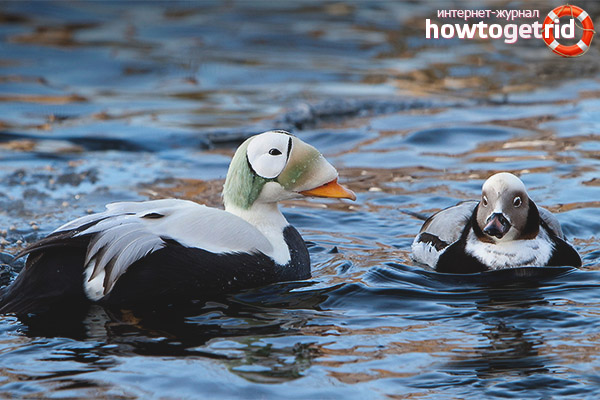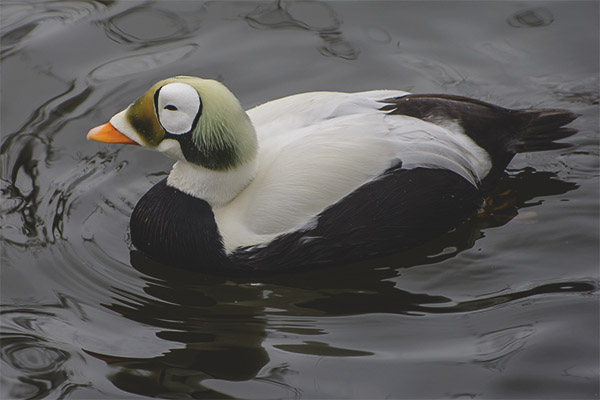The content of the article
Among the numerous species of waterfowl, one can distinguish the eyegrow eider, which is also called phisher. The first name is absolutely clear - it is caused by the unusual color of the eider, which seems to be wearing beautiful white glasses, which almost completely hide the halo of the eye. The Fisher eagle is named after the discoverer of this species, Grigory Fisher, who was a famous Russian scientist - zoologist, ornithologist, biologist, etc. What is a bird, how does it look and where does it live? Let's try to understand this article.
Description of the appearance of spectacled eider
The Fisher gaga is large enough, one of the largest family of ducks. It has a large head, a short massive neck and a long, wedge-shaped beak. Body length is about 55-60 cm, the weight of the average male is about one and a half kilograms.A drake of spectacle eider by color can be compared to a male common eider - it has the same soft cream-colored top, a smoky area of feathers over the tail and in the abdomen area. But in the usual eider, the breast has a pinkish color, but the spectacle has a different black plumage. A distinctive feature of the bird of this species is the huge spots around the eyes, which gave the eider its name. The drakes are white with a black border, while the females are brown or gray. Another peculiarity is a rather wide and large mandible, which stands out noticeably in individuals of both sexes. On the back of his head, the spectacled eider has beautiful elongated feathers that form a mane or tuft. The color of the male is very bright - the forehead and cheeks, and the upper part of the head is green, the beak is flashy orange. A similar color is typical for the mating season, but in summer the brightness of the dress is lost, the male acquires more uniform gray shades. The female of the spectacled eider differs little from the usual representative of the species, in any period of the year it has a brown color with small bright patches. From other species, the female of spectacle eider differs only in its characteristic spots around the eyes.
The habitat of spectacle eider
Nutrition and nesting
The spectacled eider is not a bird of prey; it feeds mainly on mollusks, after which it is necessary to dive to great depths. In addition, the eider can eat crustaceans and small fish, but this is not the main diet of its food. During the nesting period, when the eider spends most of its time on the shore, birds enjoy eating berries, young shoots, and grass seeds. The diet also contains various insects and their larvae.
The spectacled eider arrives to the nesting sites already in the formed pair, the female herself finds a place to build a nest. As a rule, this is a place from which the neighborhoods near the coast of lakes with low swampy areas are clearly visible. The spectacled eider nests separately from other birds and even relatives. Rarely, several pairs of spectacled eider can live on rugged coastal areas. In a dry grassy shelter, the female rakes moss or soil, lines the bed of the nest with weeds. In laying usually about 5 eggs that are demolished in a row for several days. The female carefully covers her offspring with warm down, pulled out of her plumage. The future mommy sits on the eggs tightly enough, protects the chicks, even if the person comes to the individual as close as possible. The clutch lasts about 3-4 weeks, the chicks hatch all together, with an interval of several hours. Males do not participate in incubation and feeding of chicks, immediately after laying the last egg, they fly away. Immediately after the chicks hatch, the female takes them to the water. As a rule, the first 2-3 months chicks live in freshwater bodies of water, and only when they fully support themselves will the mother hold the brood to the sea, where the teens gradually disperse.
Interesting facts about the spectacle gaga

The more we learn about birds of different species, the more diverse and surprising their life seems.
- Most of the chicks of the spectacle eider do not survive because of predators who are not averse to eat the young brood. Birds of prey find their prey by the characteristic squeak of chicks, which is distributed from dense thickets.
- Collecting fluff of the spectacle eider is not practiced, unlike the ordinary bird of this species. From fluff, ordinary eider makes incredibly soft and warm blankets and pillows that can protect from the cold even in severe frosts. Pooh is collected in nests where chicks were bred - the eider population does not suffer in this way. It is also a valuable product for the manufacture of mountaineering clothing.
- To protect all types of eider in Canada, the reserve St. Hubert was built.
- The bird is considered to be quite quiet, characteristic sounds can be heard only during the mating season. And the males in cries resemble an eagle owl, and the sounds of the female, as a rule, look more like a duck.
- During the formation of the pair, the male strenuously cares for the female, cooing and courting his lady's heart. A point gaga is one of the longest courtship periods among all birds of a given species.
The spectacled eider has an unusual appearance, which sometimes seems funny and even absurd. However, the bird is really intelligent and peculiar, which allowed it to occupy a worthy place among the pets in the hearts of many bird watchers.











To send